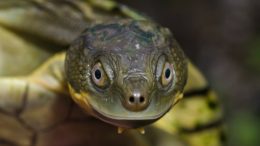In most cases an extinction takes decades of slow attrition and population declines — a death by a thousand cuts.
Sometimes, though, a species can nearly vanish in the blink of an eye.
Take the strange, scary case of the Bellinger River snapping turtle (Myuchelys georgesi). A few years ago, an estimated 4,500 of these colorful critters swam the waters of the Australian water system for which they were named, a 44-mile river in the state of New South Wales, about six hours north of Sydney. They were probably never a populous species, and they faced a few problems from egg-eating predators, but otherwise these turtles hung on just fine.
Then disaster struck.
In 2015 canoeist Rowan Simon and a friend were paddling down the Bellinger River when they noticed a turtle sitting on a rock. It should have jumped back into the water as they approached. It didn’t. They got closer and found a shocking sight — its eyes “were grown over with this disease,” as Simon recounted to the Sydney Morning Herald last year. They found another sick turtle 20 minutes later.
That was the first sign of a disease that, in under two months, would wipe out more than 90% of the species. In addition to blindness, the virus reportedly caused inflammatory lesions and internal organ failure.
Today as few as 150 Bellinger River snapping turtles remain, making them one of the world’s 25 rarest turtle or tortoise species. Australia has declared them critically endangered and devoted hundreds of thousands of dollars toward the species’ conservation.
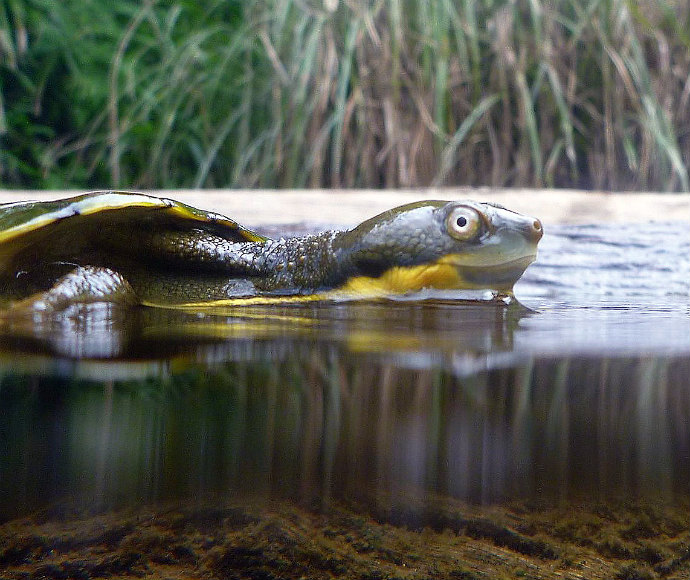
“I don’t know of any similar wildlife mortality like this,” says ecologist Bruce Chessman of the University of New South Wales-Sydney. “Of course, the chytrid fungus has wiped out some amphibian species quickly, but I don’t know of anything equivalent with turtles.”
Chessman served as the lead author of a recent paper that provided an estimate of the Bellinger River snapping turtle’s precipitous decline. “There’s a lot of uncertainty because, as the paper says, trying to get a reliable estimate of a very rare species over 70 kilometers of river is quite challenging. But we think it’s about 150-200 animals remaining. The risk of extinction is real because of the small number left.”
Virus-plus?
The researchers also examined several hypotheses about how a previously unknown and still unidentified virus could have killed so many turtles so quickly.
They didn’t find much.
“It’s all a bit of a mystery,” Chessman says. “There’s still so much we don’t know. We know it’s a reptile type of virus, but we have no idea where it came from, how long it’s been in the Bellinger River, or how it managed to apparently spread upstream rather than downstream at a rate of up to a kilometer a day, which is really quite bizarre.”
Previous research had suggested that some additional contributing factor — perhaps abnormal water temperatures, pollution or malnutrition — may have magnified the effects of the virus so that it caused so many fatalities. Current research, however, has found no specific evidence to support those hypotheses — at least, not yet.
“We can’t rule out that some sort of unusual environmental conditions in the preceding months were related to it somehow, but we don’t really have the information to understand what that was or what it may have been,” says Chessman. “Unfortunately, there isn’t that much information about what happened in the river until these sick and dead turtles started showing up in February 2015.”
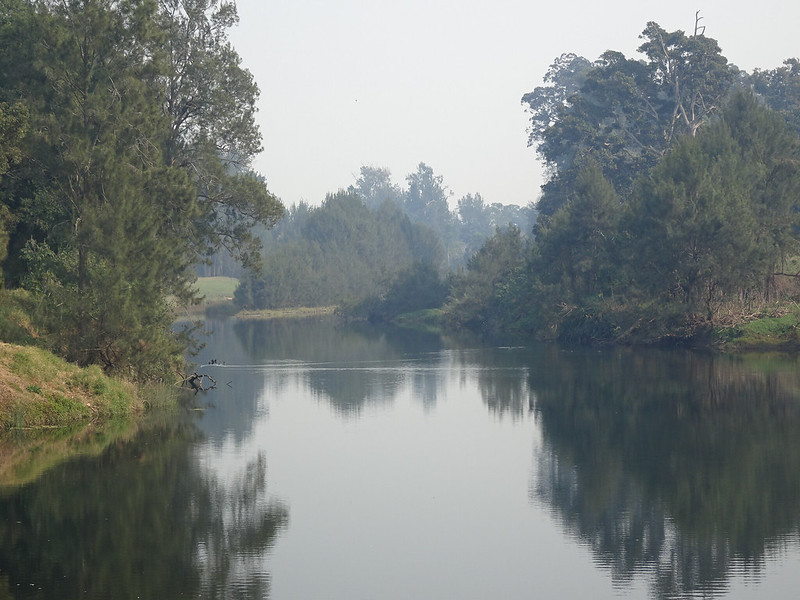
Even our understanding of the virus — what it does and how it kills — continues to lag.
“Because the species is so critically endangered now, it’s not permissible to try infection trials with the few adults that are remaining,” Chessman explains. “So it’s still not possible to get that experimental confirmation about what infection with the virus really does to the turtles.”
All of this leaves the teams working to conserve the turtles with a great deal of uncertainty.
“We really don’t know what the prospects are in terms of further disease outbreak and mortality,” Chessman says. The few remaining turtles also face threats from predators, mostly introduced red fox, as well as from native species such as monitor lizards.
There’s also a genetic threat. Another Australian turtle species, the Macquarie turtle (Emydura macquarii), appeared in the Bellinger River in recent years. The newcomers are slightly more aggressive than the native species, so they outcompete them for food, and there’s evidence they’ve started to breed and hybridize with Bellinger River snapping turtles.
“The challenges are ahead,” Chessman says. “But everyone’s giving it their best.”
That “everyone” includes the NSW Department of Planning Industry and Environment, other government organizations, local conservation groups and experts around the world.
And that collaboration may represent hope for the species.
The Last Chance Leads to the Next Generation
After his first warnings reportedly fell on deaf ears, Rowan Simon and another friend returned to the river, where they gathered up 50 dead and dying turtles and presented them to the local council.
The collection process “was pretty horrific,” Rowan told the Sydney Morning Herald.
That confrontation finally motivated action. But by then — just two months after the first signs of the disease — very few turtles were left.
At the last minute, conservation teams rescued 17 healthy mature and immature Bellinger River snapping turtles from an upper stretch of the river the disease hadn’t yet reached. They soon became the core of a captive-breeding population at Sydney’s Taronga Zoo. Another 19 immature turtles (also healthy) were collected in November 2016 and sent to Symbio Wildlife Park to start a second captive-assurance population.
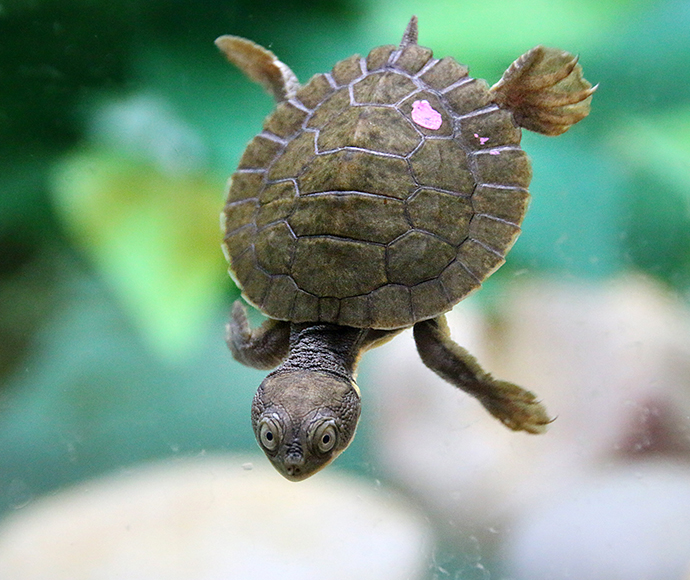
That effort has paid off — and probably saved the species from extinction.
The captive turtles promptly got down to business and started breeding. Today more than 130 healthy turtles live at the two breeding facilities. Taronga Zoo announced the birth of the most recent 35 turtle babies this past May.
More importantly, 20 captive-born animals have been released back into the river, where they’re constantly monitored through surveys and radio transmitters.
So far the released turtles appear to be healthy, and their survival rate remains quite high. As of this past March, 17 of the released turtles were still being tracked; one turtle had died, while two more had disappeared after their tracking devices failed. That month 16 of the released hatchlings were collected, tested and rereleased. Gerry McGilvray, co-lead of the Bellinger River turtle conservation program for the NSW government, told The Guardian that the youngsters “appear to be in good health and there’s no evidence of exposure to the virus.”
That makes the Bellinger River snapping turtle an interesting parallel to the current COVID-19 pandemic: The virus seems to have caused greater mortality levels in adults than in immature turtles, for as-yet-unknown reasons.
“The older ones seemed more susceptible than the younger ones, which of course is true with coronavirus as well,” says Chessman.
A Long Road Ahead
Of course, you need to produce a huge number of hatchlings to make up for losing 90% of a species. That will take time — a lot of it — and the effort faces some very strict physical limitations.
For one thing, very few mature females remain — just 5% of the total wild population. On top of that, 88% of the remaining turtles are immature, meaning they won’t reach breeding age for several years — another 10-12 years in the case of the released hatchlings.
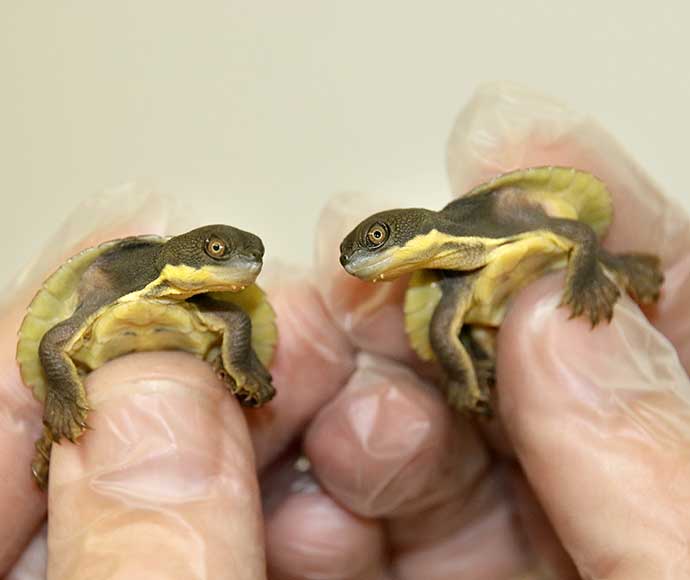
That means it would take decades for the population to come anywhere close to recovery even if the zoos keep producing and releasing young, and if the virus doesn’t have a resurgence.
That timeline shouldn’t come as a surprise, as it often takes decades for threatened species to recover once (or if) the threat that put them at risk is contained. As examples, the Chessman team’s paper points out the difficulties faced by two other turtle species that faced enormous declines:
…a population of northern map turtles (Graptemys geographica) in the USA took 27 years to recover after a period of harvesting in which abundance declined by ~50% … and there was no recovery of a common snapping turtle (Chelydra serpentina) population in Canada 23 years after loss of 39% of nesting females to predation by otters…
For now, though, the Bellinger River snapping turtle’s declines have ceased.
The biggest question, though, is whether that status quo will persist.
“The means of recovery are in place, potentially, but there’s ongoing uncertainty about further mortality from disease,” says Chessman. “We just don’t know really what’s going to happen to these young turtles that are being released once they reach maturity. Will they then succumb to the disease and die, or was it perhaps more of a one-off event?”
Other uncertainties include the potential threat of more bushfires like the ones Australia experienced earlier this year. Several media reports have suggested debris from the fires fell into the Bellinger River, potentially affecting the turtles’ food supplies. (Despite more than four months of inquiries, the NSW Department of Planning, Industry and Environment’s public affairs office would not answer questions about how the fires may have affected the river.)
Extinction Inspiration
Although we don’t know much about the river basin’s water quality before the turtles got sick, we know a lot more about it now — because this near-extinction has motivated the community.
Soon after news of the virus and mass turtle deaths emerged, a group of citizens banded together to form Bellingen Riverwatch (named after the nearby town with a slightly different name than the river itself). Now community volunteers, schools and other organizations conduct monthly water-quality tests across three rivers, a process that’s continued even amid the pandemic.
The results have been mostly good, with a few concerns. Elevated phosphate levels have shown up several times. Tests for February and March found that several sites that, at certain moments, failed to meet guidelines for dissolved oxygen established by the Australian and New Zealand Environment and Conservation Council, indicating unsafe conditions for “aquatic life and the macroinvertebrates that our turtles love to eat.” The water’s oxygen content is potentially important for the Bellinger River turtle, a butt-breathing species that takes in some oxygen through its cloaca while it’s underwater. If a turtle can’t get enough oxygen from the water, it must come to the surface, putting it at increased risk of predation. Although concerning, there’s no indication this is currently a threat to the species.

But the most recent Riverwatch report, published June 24, found the river to be in “great” shape, with no visible pollution in most sites and only slight rises in certain phosphate levels or algae in others.
Swimming Forward
Although many questions remain, the Bellinger River snapping turtle appears to have been saved from extinction — for now.
Of course, the threat of another potential outbreak still looms large — as it does for other wildlife species and even people around the world.
“Situations like this are of course unpredictable and could in theory happen anytime and anywhere — kind of like COVID,” says biologist Craig Stanford, the lead author of a new study about the threats faced by the world’s turtle and tortoise species. What’s happening with the Bellinger River turtle, he says, “concerns all of us, but it’s hard to take lessons from it to prevent something like this from happening in the future.”
But there’s one lesson from the Bellinger River that we can all carry forward: If you see a turtle or other animal that’s displaying signs of illness or unusual behavior, raise the alarm. It could be the start of something catastrophic — and an opportunity to bring a coalition and a community together to fight for a good cause and make a difference.
![]()

